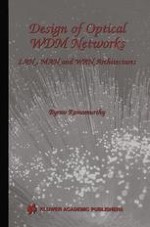2001 | OriginalPaper | Chapter
Impact of Transmission Impairments on Network Performance
Author : Byrav Ramamurthy
Published in: Design of Optical WDM Networks
Publisher: Springer US
Included in: Professional Book Archive
Activate our intelligent search to find suitable subject content or patents.
Select sections of text to find matching patents with Artificial Intelligence. powered by
Select sections of text to find additional relevant content using AI-assisted search. powered by
In a wavelength-routed optical network, a transmitted signal remains in the optical domain over the entire route (lightpath) assigned to it between its source and destination nodes. The optical signal may have to traverse a number of crossconnect switches (XCSs), fiber segments, and optical amplifiers, e.g., erbium-doped fiber amplifiers (EDFAs). Thus, while propagating through the network, the signal may degrade in quality as it encounters crosstalk at the XCSs and also picks up amplified spontaneous emission (ASE) noise at the EDFAs. Since these impairments continue to degrade the signal quality as it progresses towards its destination, the received bit-error rate (BER) at the destination node might become unacceptably high. Previous work on the lightpath routing and wavelength assignment (RWA) problem assumed an ideal physical layer and ignored these transmission impairments. The main contribution of our work is to incorporate the role of the physical layer in setting up lightpaths by employing appropriate models of multi-wavelength optical devices (XCSs and EDFAs) such that the BER of a candidate lightpath can be computed, in advance, to determine if this lightpath should be used for the call. Features from existing RWA algorithms are integrated with our on-line BER calculation mechanism. Our simulation studies indicate that employing BER-based call-admission algorithms has a significant impact on the performance of realistic networks.
